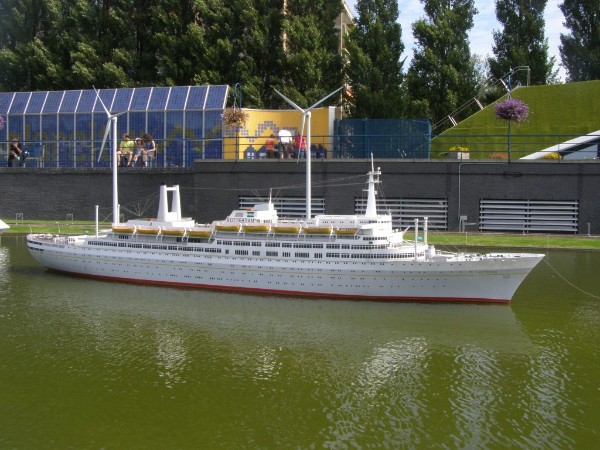Rotterdam (V)
This magnificent ship was built at the Rotterdamsche Droogdok Maatschappij as the biggest passengership ever built in the Netherlands. Her tonnage is just under 40.000 and she could accommodate 1499 passengers and 575 crew. She sailed at 21,5 knots. Her length is 228,18 meters, width 28,71 meters and her draft 9,04 meters.
In the 1950's, Holland America Line was looking for a new flagship that could sail together with the great Nieuw Amsterdam of 1938. The outbreak of the second worldwar and the shortage of materials thereafter caused the company to built a ship of that size not earlier than this. In 1956 they had introduced a moderate sized ship named Statendam but she was unable to maintain a scedule together with the much larger Nieuw Amsterdam. Two other small ships, Maasdam and Ryndam were introduced also in the beginning of the 1950's but they were build as immigrant liners and cruiseships. A true big Atlantic liner was needed to keep up with foreign competition. In the 1950's, ocean traffic on the Atlantic Ocean was booming because of warbrides and Americans who had to see their European roots. At the 13th of september 1958, Holland America was able to launch a new ocean giant from the yard of the Rotterdamse Droogdok Maatschappij in Rotterdam. She was somewhat bigger then her older fleetmate Nieuw Amsterdam and she was designed not only for line-voyages, but also with cruising in mind. Holland America Line thought forward and imagined that somewhere in the near future, airtravel would outpass oceantravel. So besides the traditional route this ship was easy to convert to sail cruises. For this purpose, even the staircase and dividing walls between classes could be changed so passengers could enjoy the whole of the ship on cruises.
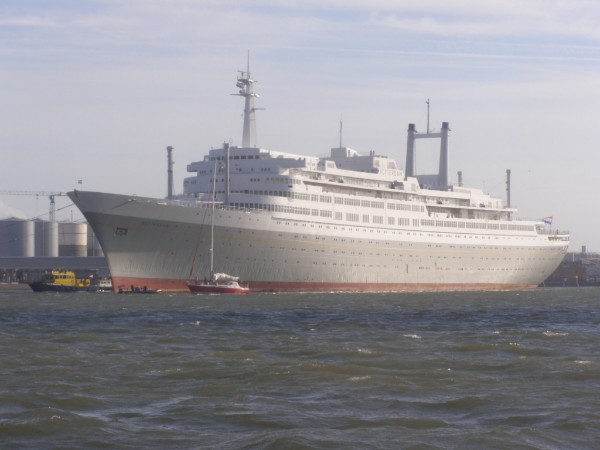
The ship was named after her homeport of Rotterdam and it was the fifth time this name was used in the history of the company. Her trials took place in july of 1959 and her first crossing to New York started in Rotterdam on the 3th of september of that year.
The ship was a true masterpiece, still recognized as one of the most beautiful oceanliners ever built to this very day. She was also the first to be built without a traditional funnel, sometimes disliked by people who did not see in her a true ship. But at least the P&O Line was impressed, because they adopted this idea for their new flagship Canberra that entered service in 1960. For the interiour, a lot of Dutch artists were invited to turn the ship over to some sort of museum of Dutch art of this time. In 1970, the Rotterdam was taken out of her transatlantic service. Now only the Nieuw Amsterdam continued these line-voyages untill 1974 when this old ship sailed for the breakers yard. Several plans to preserve this ship failed. There even was a plan to use the Nieuw Amsterdam as an erotic centre in Rotterdam.
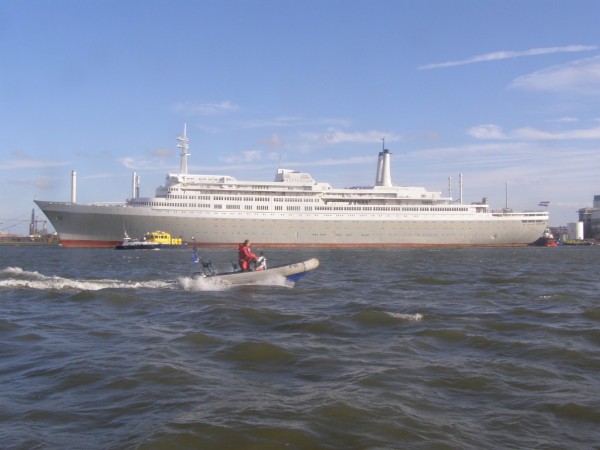
When Rotterdam was taken out of transatlantic service in 1970, she left her homeport and did not come back there untill 1998. But still, Dutch people admired the ship all the time when she was sailing for Holland America Line. In 1973, her homeport changed from Rotterdam to Willemstad on Curacao and also the location of the Holland America Line headoffice was changed to Willemstad, leaving The Netherlands itself without a big company owning passengerships, although Curacao is part of the Kingdom of the Netherlands so the ships were still Dutch.
A few problems happened to the Rotterdam in the 1970's, in 1973 a dockwall almost collapsed when the ship was in drydock in Lisbon and she was nearly destroyed. In 1976, a giant wave caused considerable damage to the ship but this could be repaired. Furthermore, her carreeer with Holland America Line was very succesful and her fame spread around the world. Holland America Line kept her in service untill 1997, a remarkable 38 years. For a ship that was built as a transatlantic liner this is exceptional. She was maintained very well untill the last days she sailed for Holland America Line, even named the 'Ship Of The Year' in 1997. She just was not able to give her passengers all modern needs and that was the reason she had to go. Also, she was still a steamship, never rebuilt as a motorship and it became less economical to run the ship in the premium brand Holland America was.
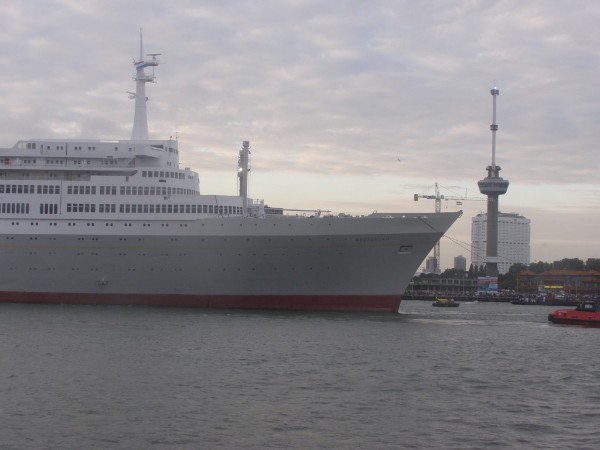
Rotterdam was sold to Premier Cruise Line, a company that specialized on older cruiseships and was sailing Caribbean cruises. The ship was renamed Rembrandt to not loose her Dutch history. Premier Cruises did give the Dutch fans of the ship a present when they decided to let the ship come back to Holland once more in the late summer of 1998. A lot of people went to the harbour to see her, asuming that it was their last chance. Premier Cruises started to give all of their ships red hulls from the late 1990's onwards, and renamed them The Big Red Boat I, II and III. The Rembrandt kept her name and darkblue hull.
Below, Rembrandt is seen passing Hoek van Holland on her last cruise from The Netherlands in 1998. This is actually one of the last pictures ever taken of her leaving her former homeport.
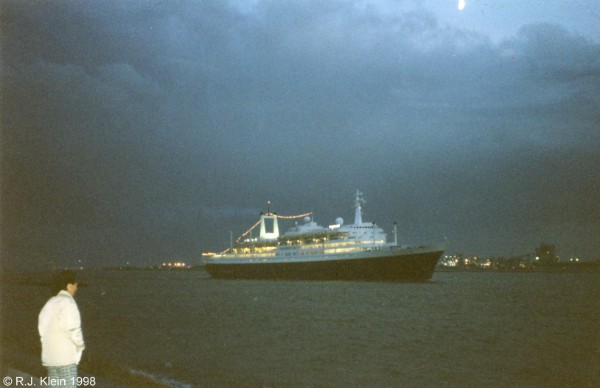
In 2000, Premier Cruises went bankrupt and all cruises were ended abruptly. Passengers had to embark in the next port of call and fly home themselves. Rembrandt embarked her passengers in Halifax, Canada. and was later laid up in Nassau on the Bahamas awaiting a buyer. Several scemes were put up, but the ship remained there untill she was bought by the Rotterdamse Droogdok Maatschappij, the company who build the ship. Because of the problems to finance this, the RDM went bankrupt. The Rotterdam harbour company, who also financed this partly together with the RDM also got into big troubles, but of course it was impossible for this company to go bankrupt. The council of Rotterdam was not pleased.
The thought that the ship would be scrapped was very real in this time. But in 2005, a year after the debacle of the RDM, the ship was bought by a consortium of Eurobalance and Woonbron, two Dutch companies. Woonbron is a Dutch housing company who estimated that rebuilding the ship would cost around 4 million euros. They planned to bring the ship back to Rotterdam in 2007 and use her as a museum, learning center for the hotelschool and hotel/ restaurant. The ship was towed to Gibraltar and the rebuilding began. A lot of problems arose when the asbestos had to be removed from the ship and the costs rose higher than expected. The ship was again renamed Rotterdam and was towed to Gdansk for further reparations. Here again problems arose when Polish workers refused to get the asbestos out. The ship was towed again to Wilhelmshaven in Germany and work started. At this time it was estimated that the whole conversion had cost around 200 million euros, somewhat more than Woonbron had announced. The whole company of Woonbron was worth almost this count and questions arose in Rotterdam if this was a good choise for a company that was supposed to create housing in some poor parts of the city of Rotterdam. Also, national politics started the debate and an inspector of the Secretary of Housing was sent down to Rotterdam to have an overview on the project. Although there were many complaints about the way everything was organised, the ship came finally back to Rotterdam in august 2008. First, the ship was to open for the public in november 2008 but that date was set forward to the end of july 2009. Finally, after some more delays, mostly because her interiour would not be ready on time, the ship opened at the 5th of february 2010.
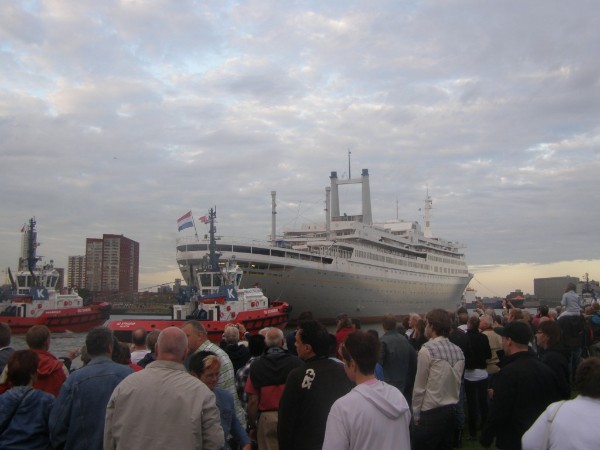
The picture above is showing Rotterdam on her current berthingplace, close to the old Holland America Line terminal, underneath is another picture of her arrival in Rotterdam and below that is how she looked in february 2010, some weeks before opening to the public, with also her lifeboats again in place.

At the end of 2012, because of the high costs that were made during the rebuilding of the ship for her current role, it was announced that the ship would be put up for sale again. The company Woonbron simply has to sell the ship because of heir current financial position. There are talks going on with several parties, also one from Oman. When the ship is sold to this company, it seems likely that she will move to Oman in the future to be used as a VIP-ship there. Woonbron likes to see that the ship will stay in Rotterdam, but the money that can be put forward in the Gulf-state of Oman may be an offer they cannot refuse. So at this moment, it seems there still is no rest for the old lady.
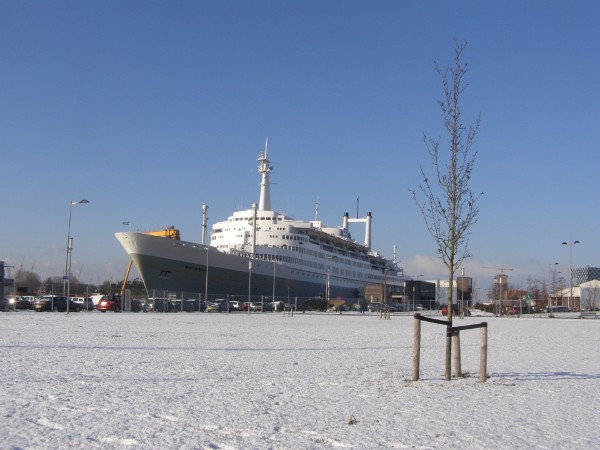
An important ship as this, has of course a great modelship too. In the miniature city of Madurodam, that is located in The Hague, a very large model of the ship is present, very close to a model of the former headoffice of the Holland America Line, nowadays the Hotel New York. At Madurodam, a lot of Dutch landmark buildings are brought together in miniature scale. A picture of the Madurodam model is shown below. While her normal sized sister was rebuilt, the model too was rebuilt by students of the Albeda College at Rotterdam, one of the schools that were going to use the ship for educational purposes. The ships model was carefully rebuilt to be an exact copy of the original, after the model had been repainted in an unsuitable way, representing a ship that wasn't a true replica. To add to the historic story, the ships Madurodam model was rebuilt and repainted at the former buildings sheds of the Rotterdam Drydock Company, the place where the ship was built at the end of the 1950's.
